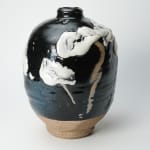Shimizu Uichi 清水 卯一 Japanese, 1926-2004
Flat jar with white glaze on gloss iron glaze 鉄耀白流扁壺
Stoneware
H10 3/4 × W8 3/8 × D7 1/4 in.
H27.3 × W21.1 × D18.4 cm
H27.3 × W21.1 × D18.4 cm
With signed wood box
Sold
Further images
-
(View a larger image of thumbnail 1
)

-
(View a larger image of thumbnail 2
)

-
(View a larger image of thumbnail 3
)

-
(View a larger image of thumbnail 4
)

-
(View a larger image of thumbnail 5
)

-
(View a larger image of thumbnail 6
)

-
(View a larger image of thumbnail 7
)

-
(View a larger image of thumbnail 8
)

-
(View a larger image of thumbnail 9
)

-
(View a larger image of thumbnail 10
)

-
(View a larger image of thumbnail 11
)

-
(View a larger image of thumbnail 12
)

-
(View a larger image of thumbnail 13
)

-
(View a larger image of thumbnail 14
)

-
(View a larger image of thumbnail 15
)

Shimizu Uichi was designated a living national treasure for his contributions using iron-containing glazes (tetsu-yu). His predecessor for this title was the great Ishiguro Munemaro (1893-1968), one of the original...
Shimizu Uichi was designated a living national treasure for his contributions using iron-containing glazes (tetsu-yu). His predecessor for this title was the great Ishiguro Munemaro (1893-1968), one of the original ceramic artists designated a title in the very first group of Living National Treasures in 1955. Iron-rich glazes often suggests black or brown coloration but Shimizu Uichi created orange, white and celadon shades as well as his mastery over the metallic glaze. As with the glazes used by Shoji Hamada iron containing glazes date back to Northern Song Dynasty wares but in Shimizu’s hands they were modernised and used on graceful forms to create a different way of using these glazes.
Alongside Hayashi Yasuo, Shimizu Uichi was a part of the avant-garde ceramicist group “Shikokai 四耕社” in the Kyoto scene during the post-war period in the 1950s and 60s. The movement permitted potters to re-conceptualize pottery outside of industry traditions of Japanese ceramics, which had been dominated by the idea that lineage- rather, potters who were children of pottery masters- granted credibility to ceramicists. Shimizu’s frank boldness rippled through the ceramics world in Japan and created fresh aesthetic values, tenets, and precedents for what permitted a ceramic art object.
Alongside Hayashi Yasuo, Shimizu Uichi was a part of the avant-garde ceramicist group “Shikokai 四耕社” in the Kyoto scene during the post-war period in the 1950s and 60s. The movement permitted potters to re-conceptualize pottery outside of industry traditions of Japanese ceramics, which had been dominated by the idea that lineage- rather, potters who were children of pottery masters- granted credibility to ceramicists. Shimizu’s frank boldness rippled through the ceramics world in Japan and created fresh aesthetic values, tenets, and precedents for what permitted a ceramic art object.














